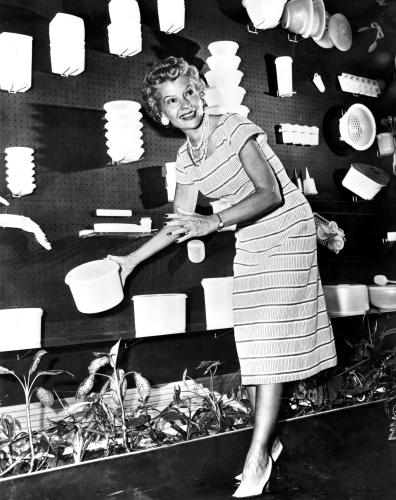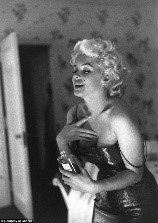Brownie Wise – the Queen of Tupperware
This week’s story is a little longer than usual but I would recommend you stick with it. The story of Brown Wise is an amazing one and one I wish I could take an option on to turn into a screenplay.
In 1956 the Houston Post reported that “It has been estimated that Brownie Wise has helped more women to financial success than any other single living person.”
But who was Brownie Wise and what was the brand on which her and so many other women’s success was built?
Brownie’s story starts when she was born in rural Georgia and given her name for her big, brown eyes. Her parents divorced, and, as a teen, she travelled with her mother, who organised union rallies. It was on these trips that Brownie started giving speeches and soon proved to be an extraordinarily gifted and motivating orator. She “awed people,” wrote her biographer Bob Kealing “[They] were surprised that someone so young could deliver a speech like a pastor.”
The next stage on her path to success started with a bad door-to-door salesman. When a Stanley Home Products salesman knocked on her door and proceeded to deliver a terrible sales pitch for cleaning supplies, Wise scoffed and said she could do better.
By coincidence Stanley had just started experimenting with home parties as a sales method and the salesman said if Brownie was so sure of herself why didn’t she show them what she could do. She jumped at the chance and started selling Stanley products at parties. Before long she was making enough money to quit her secretarial job.
Wise was blessed with the gift of the gab. She quickly started to rise through Stanley’s ranks and she was soon in management and hoping to ascend even higher. However those aspirations were quashed at a meeting with Stanley’ head, Frank Beveridge, who told her she’d never become an executive. Its halls were “no place for a woman,” he said.
She was furious and started to look for other opportunities and it was a near-accident at a sales meeting that was to give her inspiration. One of her co-workers had seen some plastic storage tubs gathering dust in a department store and decided to bring them in. At first Wise didn’t think they were anything special, but when she accidentally knocked a bowl off the table, it bounced instead of breaking, and the contents remained safe inside. Brownie saw the potential there and then.
The brand was Tupperware and, looking at it more closely, Brownie could see it looked attractive, came in attractive pastel colours and flexible shapes but above all it was extremely functional. Convinced of its potential, Wise left Stanley and in 1949 started throwing parties to sell Tupperware. It was a move that was to spark a mini revolution; Tupperware didn’t just help extend the life of leftovers, it was to become a career maker for Brownie and millions of other women.
Many of the women who came to one of Wise’s parties, were convinced not only to buy the products but to become Tupperware salespeople themselves.
As she hosted more and more parties, Brownie discovered more and more ways to convert women into Tupperware loyalists and advocates. She found that putting people on waiting lists, something she was initially reluctant to do, actually made them more eager to buy.
She quickly amassed outstanding sales but equally importantly she started to build her team of more and more saleswomen, and they in turn built their own networks. Soon, other Tupperware parties were taking place across the country. Wise’s team in Detroit was selling more Tupperware than most department stores. This soon attracted the attention of the founder of the Tupperware Corporation, Earl Silas Tupper.
He offered her a promotion: distribution rights for the entire state of Florida. In the spring of 1950, she moved south with her son and mother.
However things didn’t go as smoothly as she hoped; there were disputes over turf with other distributors but what annoyed her most was that she was constantly contending with botched orders, shipping delays and product shortages.
In March of 1951 Wise had had enough. She called Tupper in a fury and demanded action – this was hurting not just her bottom line, but also his. Tupper listened and assured her that he’d fix the issues but wanted a favour; to hear her sales secrets and thoughts on growing the business.
The next month, the two met at a conference on Long Island and Wise explained her belief in the power of parties where people could touch Tupperware, squeeze it, drop it and seal it in the company of trusted friends or neighbours. With regard to growing the business, her suggestion was radical: ditch department stores altogether and focus entirely on throwing home parties.
 Tupper took the advice to heart and the day after their meeting he created a new division just for home parties and asked Wise to be the general manager. The halls of Tupperware executives weren’t closed to women. Her stellar track record continued – she was selling more Tupperware than anyone anywhere.
Tupper took the advice to heart and the day after their meeting he created a new division just for home parties and asked Wise to be the general manager. The halls of Tupperware executives weren’t closed to women. Her stellar track record continued – she was selling more Tupperware than anyone anywhere.
The new approach saw Tupperware sales rocket, wholesale orders exceeded $2 million in 1952. Tupper increased her salary to $20,000 and, on her birthday in 1953, he presented her with a gold-dyed palomino horse. He also gave her the freedom to do practically whatever she wanted.
Wise started travelling the country recruiting, presiding over sales conferences and announcing contests and doling out prizes as an incentive—including, sometimes, her own clothes.
The beauty of selling Tupperware at parties for many women was it allowed them to be employed, yet not appear to challenge their husbands’ authority or the status quo in what was still a very traditional male-dominated world. The parties allowed women to contribute to their family’s bottom line. Wise embraced the spirit of female entrepreneurship wholeheartedly, she wrote a newsletter called Tupperware Sparks, published a primer called Tupperware Know-How, and had a 52-minute film, A Tupperware Home Party, made as a training tool
Wise had become the face of Tupperware, the result of her success, but unfortunately it also sowed the seeds of discontent with Tupper. In 1954, she was the first woman to appear on the cover of Business Week. The magazine’s profile was glowing to say the least. It credited Wise and her sales technique with Tupperware’s estimated $25 million in retail sales whilst seeming to downplay Tupper’s role as president of the company he had created.
Tupper had never craved the spotlight for himself; in fact, he was known to use the back door of his office, but he believed the focus should be on the product and not the employees. After the Business Week article, Tupper sent a note to Wise “However good an executive you are, I still like best the pictures … with TUPPERWARE!”
It was the beginning of the end. Their relationship started to deteriorate and, in 1958, Tupper fired Wise. After a heated legal battle, she received only $30,000 as a settlement. She had no stocks in the company.
Tupper ordered her name expunged from the company history and buried the 600 remaining copies of her book in an unmarked pit behind Tupperware’s Florida headquarters. Later that year he sold the company to Rexall Drug for $16 million.
Wise tried starting new companies but never achieved the same success she had with Tupperware. She ended up leading a quiet life, with her horses, pottery and her son until she died at her home in 1992.




 Greggs is a family bakery business that was founded on Tyneside in the 1930s when John Gregg delivered eggs and yeast to local families on his pushbike. It now has more than 1,000 bakery stores across the UK, though obviously not in Mayfair. It is not a “sexy” brand; rather it is a down-to-earth brand of the people and for the people.
Greggs is a family bakery business that was founded on Tyneside in the 1930s when John Gregg delivered eggs and yeast to local families on his pushbike. It now has more than 1,000 bakery stores across the UK, though obviously not in Mayfair. It is not a “sexy” brand; rather it is a down-to-earth brand of the people and for the people.


 “The precise circumstances under which the idea for The Furrow was hatched are unclear. I can tell you the company was under the direction of John Deere’s son, Charles, when The Furrow was first published. Charles was known as a fairly astute marketer; he recognized farmers’ need for an accurate, unbiased source of information, and recognized the marketing potential associated with providing that information” said David G. Jones, the current Publications Manager.
“The precise circumstances under which the idea for The Furrow was hatched are unclear. I can tell you the company was under the direction of John Deere’s son, Charles, when The Furrow was first published. Charles was known as a fairly astute marketer; he recognized farmers’ need for an accurate, unbiased source of information, and recognized the marketing potential associated with providing that information” said David G. Jones, the current Publications Manager. And it’s a formula that remains successful, today, the magazine reaches about 570,000 consumers in the U.S. and Canada, and about 2 million globally.
And it’s a formula that remains successful, today, the magazine reaches about 570,000 consumers in the U.S. and Canada, and about 2 million globally.

 Although the founders’ names were obviously still going to be attached to the brand, neither of them was to hold any board or management position and neither was to be involved in day-to-day management of the company.
Although the founders’ names were obviously still going to be attached to the brand, neither of them was to hold any board or management position and neither was to be involved in day-to-day management of the company. However the choice of the new CEO was still going to be crucial; Yves Couette was that choice.
However the choice of the new CEO was still going to be crucial; Yves Couette was that choice.